Zackory Erickson
ORB: Operating Room Bot, Automating Operating Room Logistics through Mobile Manipulation
Sep 19, 2025
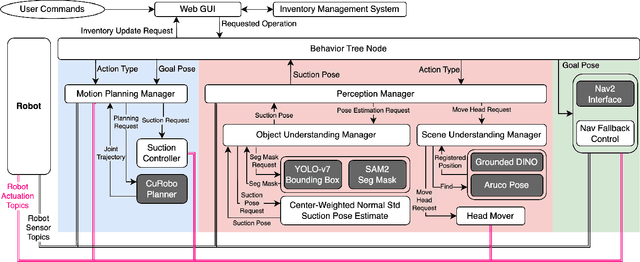


Abstract:Efficiently delivering items to an ongoing surgery in a hospital operating room can be a matter of life or death. In modern hospital settings, delivery robots have successfully transported bulk items between rooms and floors. However, automating item-level operating room logistics presents unique challenges in perception, efficiency, and maintaining sterility. We propose the Operating Room Bot (ORB), a robot framework to automate logistics tasks in hospital operating rooms (OR). ORB leverages a robust, hierarchical behavior tree (BT) architecture to integrate diverse functionalities of object recognition, scene interpretation, and GPU-accelerated motion planning. The contributions of this paper include: (1) a modular software architecture facilitating robust mobile manipulation through behavior trees; (2) a novel real-time object recognition pipeline integrating YOLOv7, Segment Anything Model 2 (SAM2), and Grounded DINO; (3) the adaptation of the cuRobo parallelized trajectory optimization framework to real-time, collision-free mobile manipulation; and (4) empirical validation demonstrating an 80% success rate in OR supply retrieval and a 96% success rate in restocking operations. These contributions establish ORB as a reliable and adaptable system for autonomous OR logistics.
Force-Modulated Visual Policy for Robot-Assisted Dressing with Arm Motions
Sep 16, 2025Abstract:Robot-assisted dressing has the potential to significantly improve the lives of individuals with mobility impairments. To ensure an effective and comfortable dressing experience, the robot must be able to handle challenging deformable garments, apply appropriate forces, and adapt to limb movements throughout the dressing process. Prior work often makes simplifying assumptions -- such as static human limbs during dressing -- which limits real-world applicability. In this work, we develop a robot-assisted dressing system capable of handling partial observations with visual occlusions, as well as robustly adapting to arm motions during the dressing process. Given a policy trained in simulation with partial observations, we propose a method to fine-tune it in the real world using a small amount of data and multi-modal feedback from vision and force sensing, to further improve the policy's adaptability to arm motions and enhance safety. We evaluate our method in simulation with simplified articulated human meshes and in a real world human study with 12 participants across 264 dressing trials. Our policy successfully dresses two long-sleeve everyday garments onto the participants while being adaptive to various kinds of arm motions, and greatly outperforms prior baselines in terms of task completion and user feedback. Video are available at https://dressing-motion.github.io/.
Geometric Red-Teaming for Robotic Manipulation
Sep 15, 2025Abstract:Standard evaluation protocols in robotic manipulation typically assess policy performance over curated, in-distribution test sets, offering limited insight into how systems fail under plausible variation. We introduce Geometric Red-Teaming (GRT), a red-teaming framework that probes robustness through object-centric geometric perturbations, automatically generating CrashShapes -- structurally valid, user-constrained mesh deformations that trigger catastrophic failures in pre-trained manipulation policies. The method integrates a Jacobian field-based deformation model with a gradient-free, simulator-in-the-loop optimization strategy. Across insertion, articulation, and grasping tasks, GRT consistently discovers deformations that collapse policy performance, revealing brittle failure modes missed by static benchmarks. By combining task-level policy rollouts with constraint-aware shape exploration, we aim to build a general purpose framework for structured, object-centric robustness evaluation in robotic manipulation. We additionally show that fine-tuning on individual CrashShapes, a process we refer to as blue-teaming, improves task success by up to 60 percentage points on those shapes, while preserving performance on the original object, demonstrating the utility of red-teamed geometries for targeted policy refinement. Finally, we validate both red-teaming and blue-teaming results with a real robotic arm, observing that simulated CrashShapes reduce task success from 90% to as low as 22.5%, and that blue-teaming recovers performance to up to 90% on the corresponding real-world geometry -- closely matching simulation outcomes. Videos and code can be found on our project website: https://georedteam.github.io/ .
RaC: Robot Learning for Long-Horizon Tasks by Scaling Recovery and Correction
Sep 09, 2025Abstract:Modern paradigms for robot imitation train expressive policy architectures on large amounts of human demonstration data. Yet performance on contact-rich, deformable-object, and long-horizon tasks plateau far below perfect execution, even with thousands of expert demonstrations. This is due to the inefficiency of existing ``expert'' data collection procedures based on human teleoperation. To address this issue, we introduce RaC, a new phase of training on human-in-the-loop rollouts after imitation learning pre-training. In RaC, we fine-tune a robotic policy on human intervention trajectories that illustrate recovery and correction behaviors. Specifically, during a policy rollout, human operators intervene when failure appears imminent, first rewinding the robot back to a familiar, in-distribution state and then providing a corrective segment that completes the current sub-task. Training on this data composition expands the robotic skill repertoire to include retry and adaptation behaviors, which we show are crucial for boosting both efficiency and robustness on long-horizon tasks. Across three real-world bimanual control tasks: shirt hanging, airtight container lid sealing, takeout box packing, and a simulated assembly task, RaC outperforms the prior state-of-the-art using 10$\times$ less data collection time and samples. We also show that RaC enables test-time scaling: the performance of the trained RaC policy scales linearly in the number of recovery maneuvers it exhibits. Videos of the learned policy are available at https://rac-scaling-robot.github.io/.
CoRI: Synthesizing Communication of Robot Intent for Physical Human-Robot Interaction
May 26, 2025Abstract:Clear communication of robot intent fosters transparency and interpretability in physical human-robot interaction (pHRI), particularly during assistive tasks involving direct human-robot contact. We introduce CoRI, a pipeline that automatically generates natural language communication of a robot's upcoming actions directly from its motion plan and visual perception. Our pipeline first processes the robot's image view to identify human poses and key environmental features. It then encodes the planned 3D spatial trajectory (including velocity and force) onto this view, visually grounding the path and its dynamics. CoRI queries a vision-language model with this visual representation to interpret the planned action within the visual context before generating concise, user-directed statements, without relying on task-specific information. Results from a user study involving robot-assisted feeding, bathing, and shaving tasks across two different robots indicate that CoRI leads to statistically significant difference in communication clarity compared to a baseline communication strategy. Specifically, CoRI effectively conveys not only the robot's high-level intentions but also crucial details about its motion and any collaborative user action needed.
Web2Grasp: Learning Functional Grasps from Web Images of Hand-Object Interactions
May 07, 2025Abstract:Functional grasp is essential for enabling dexterous multi-finger robot hands to manipulate objects effectively. However, most prior work either focuses on power grasping, which simply involves holding an object still, or relies on costly teleoperated robot demonstrations to teach robots how to grasp each object functionally. Instead, we propose extracting human grasp information from web images since they depict natural and functional object interactions, thereby bypassing the need for curated demonstrations. We reconstruct human hand-object interaction (HOI) 3D meshes from RGB images, retarget the human hand to multi-finger robot hands, and align the noisy object mesh with its accurate 3D shape. We show that these relatively low-quality HOI data from inexpensive web sources can effectively train a functional grasping model. To further expand the grasp dataset for seen and unseen objects, we use the initially-trained grasping policy with web data in the IsaacGym simulator to generate physically feasible grasps while preserving functionality. We train the grasping model on 10 object categories and evaluate it on 9 unseen objects, including challenging items such as syringes, pens, spray bottles, and tongs, which are underrepresented in existing datasets. The model trained on the web HOI dataset, achieving a 75.8% success rate on seen objects and 61.8% across all objects in simulation, with a 6.7% improvement in success rate and a 1.8x increase in functionality ratings over baselines. Simulator-augmented data further boosts performance from 61.8% to 83.4%. The sim-to-real transfer to the LEAP Hand achieves a 85% success rate. Project website is at: https://webgrasp.github.io/.
ArticuBot: Learning Universal Articulated Object Manipulation Policy via Large Scale Simulation
Mar 04, 2025Abstract:This paper presents ArticuBot, in which a single learned policy enables a robotics system to open diverse categories of unseen articulated objects in the real world. This task has long been challenging for robotics due to the large variations in the geometry, size, and articulation types of such objects. Our system, Articubot, consists of three parts: generating a large number of demonstrations in physics-based simulation, distilling all generated demonstrations into a point cloud-based neural policy via imitation learning, and performing zero-shot sim2real transfer to real robotics systems. Utilizing sampling-based grasping and motion planning, our demonstration generalization pipeline is fast and effective, generating a total of 42.3k demonstrations over 322 training articulated objects. For policy learning, we propose a novel hierarchical policy representation, in which the high-level policy learns the sub-goal for the end-effector, and the low-level policy learns how to move the end-effector conditioned on the predicted goal. We demonstrate that this hierarchical approach achieves much better object-level generalization compared to the non-hierarchical version. We further propose a novel weighted displacement model for the high-level policy that grounds the prediction into the existing 3D structure of the scene, outperforming alternative policy representations. We show that our learned policy can zero-shot transfer to three different real robot settings: a fixed table-top Franka arm across two different labs, and an X-Arm on a mobile base, opening multiple unseen articulated objects across two labs, real lounges, and kitchens. Videos and code can be found on our project website: https://articubot.github.io/.
Towards Wearable Interfaces for Robotic Caregiving
Feb 07, 2025
Abstract:Physically assistive robots in home environments can enhance the autonomy of individuals with impairments, allowing them to regain the ability to conduct self-care and household tasks. Individuals with physical limitations may find existing interfaces challenging to use, highlighting the need for novel interfaces that can effectively support them. In this work, we present insights on the design and evaluation of an active control wearable interface named HAT, Head-Worn Assistive Teleoperation. To tackle challenges in user workload while using such interfaces, we propose and evaluate a shared control algorithm named Driver Assistance. Finally, we introduce the concept of passive control, in which wearable interfaces detect implicit human signals to inform and guide robotic actions during caregiving tasks, with the aim of reducing user workload while potentially preserving the feeling of control.
LAMS: LLM-Driven Automatic Mode Switching for Assistive Teleoperation
Jan 15, 2025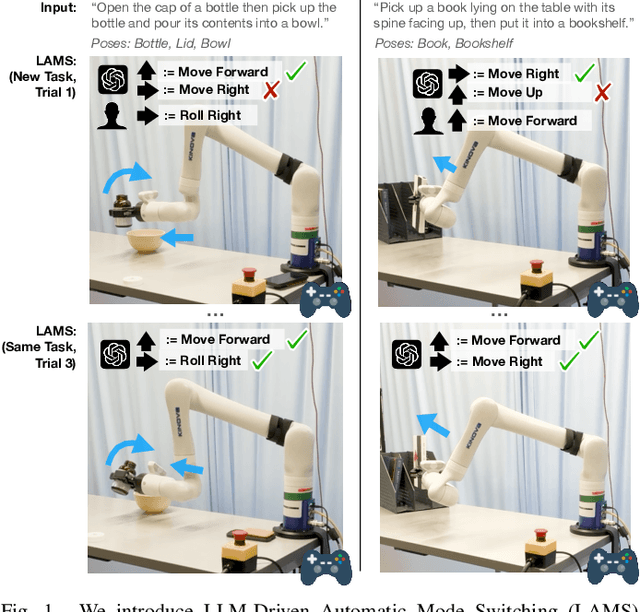
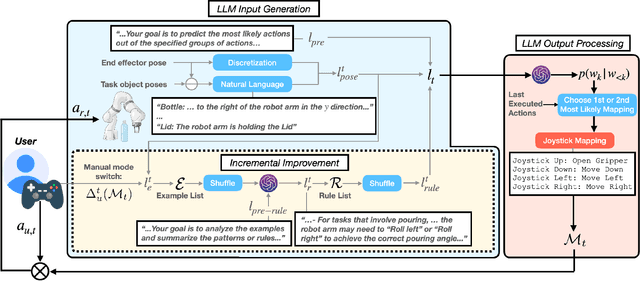
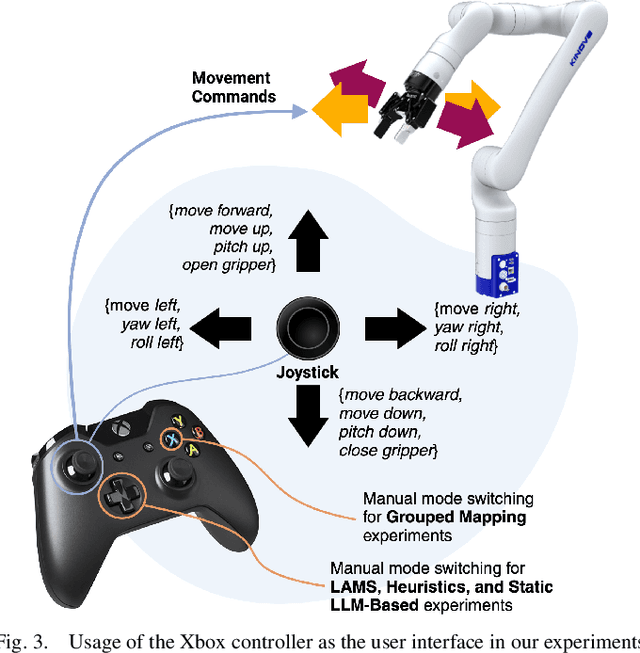
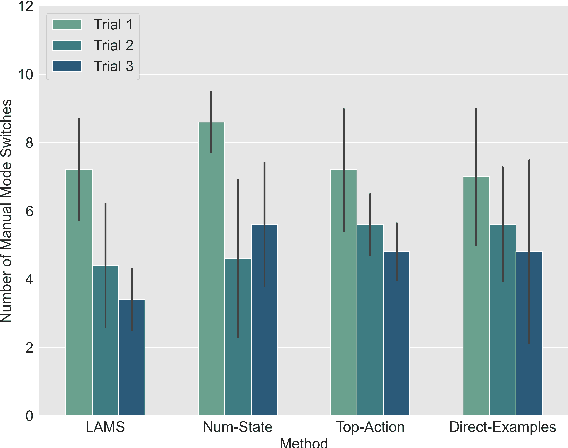
Abstract:Teleoperating high degrees-of-freedom (DoF) robotic manipulators via low-DoF controllers like joysticks often requires frequent switching between control modes, where each mode maps controller movements to specific robot actions. Manually performing this frequent switching can make teleoperation cumbersome and inefficient. On the other hand, existing automatic mode-switching solutions, such as heuristic-based or learning-based methods, are often task-specific and lack generalizability. In this paper, we introduce LLM-Driven Automatic Mode Switching (LAMS), a novel approach that leverages Large Language Models (LLMs) to automatically switch control modes based on task context. Unlike existing methods, LAMS requires no prior task demonstrations and incrementally improves by integrating user-generated mode-switching examples. We validate LAMS through an ablation study and a user study with 10 participants on complex, long-horizon tasks, demonstrating that LAMS effectively reduces manual mode switches, is preferred over alternative methods, and improves performance over time. The project website with supplementary materials is at https://lams-assistance.github.io/.
EMGBench: Benchmarking Out-of-Distribution Generalization and Adaptation for Electromyography
Oct 31, 2024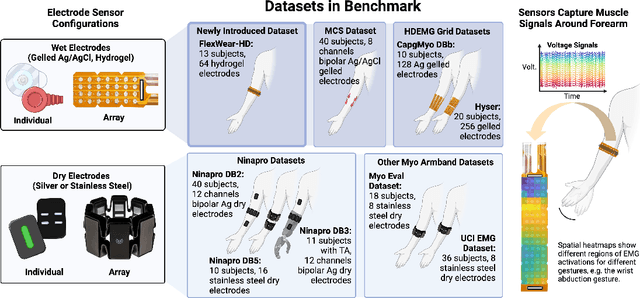

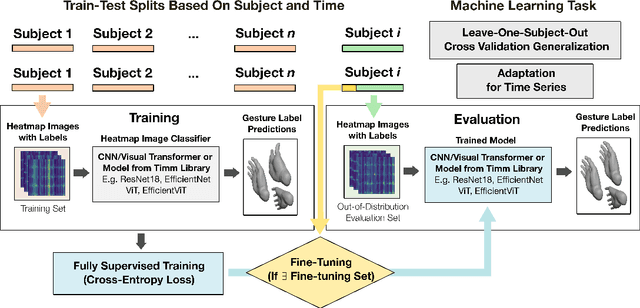

Abstract:This paper introduces the first generalization and adaptation benchmark using machine learning for evaluating out-of-distribution performance of electromyography (EMG) classification algorithms. The ability of an EMG classifier to handle inputs drawn from a different distribution than the training distribution is critical for real-world deployment as a control interface. By predicting the user's intended gesture using EMG signals, we can create a wearable solution to control assistive technologies, such as computers, prosthetics, and mobile manipulator robots. This new out-of-distribution benchmark consists of two major tasks that have utility for building robust and adaptable control interfaces: 1) intersubject classification and 2) adaptation using train-test splits for time-series. This benchmark spans nine datasets--the largest collection of EMG datasets in a benchmark. Among these, a new dataset is introduced, featuring a novel, easy-to-wear high-density EMG wearable for data collection. The lack of open-source benchmarks has made comparing accuracy results between papers challenging for the EMG research community. This new benchmark provides researchers with a valuable resource for analyzing practical measures of out-of-distribution performance for EMG datasets. Our code and data from our new dataset can be found at emgbench.github.io.
 Add to Chrome
Add to Chrome Add to Firefox
Add to Firefox Add to Edge
Add to Edge